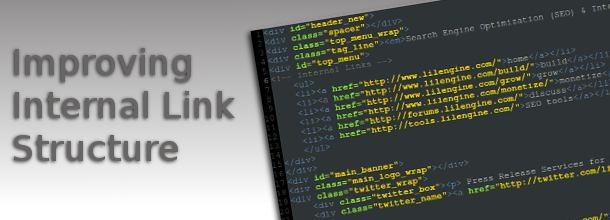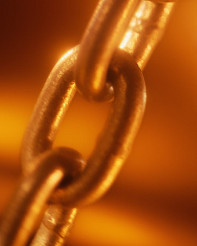Internal Link Structure, Footer Links, In Context Links

It seems we’re always hammering home the importance of link building, external links, and inbound links, and that sometimes makes us minimize the importance of the links available right there on your own pages. After all, you have complete control over the pages on your site, and if they have matured to where they have page rank, then that’s even better. There’s a lot you can do with respect to how your pages pass rank, which influences how search engines view the content on your pages.
SEO and high ranking for competitive terms actually has a lot to do with your internal link structure, though you might never know it for the choruses of “link building or die!” (which, yes, we’ve been guilty of as well). A new site that’s designed well, that’s themed and structured topically around a specific handful of keywords, has a better chance of rising to the top of the SERPs than an older site that doesn’t take this structure into account with respect to internal links, content, and naming conventions of filenames.
Optimizing Internal Linking
Since you have control over your internal pages, you might as well make the most of your on-site SEO opportunities. There’s a lot you can do to increase the relevance of all the pages on your site.

 Start by making all your links absolute and getting rid of any secondary keywords that are irrelevant. As your pages mature, you want to make sure that they have names in the format of http://www.yourwebsite.com/pagename.html. That causes your pages to boost each other in the SERPs, and ensures that if your content is copied, the links will point back to your pages, giving you another back link (hooray!).
Start by making all your links absolute and getting rid of any secondary keywords that are irrelevant. As your pages mature, you want to make sure that they have names in the format of http://www.yourwebsite.com/pagename.html. That causes your pages to boost each other in the SERPs, and ensures that if your content is copied, the links will point back to your pages, giving you another back link (hooray!).
Put a limit on your outbound links at about 10. This helps you keep your pages focused. The fewer the outbound links, the more link juice the page has to transmit to its own keywords. This should be come evident when you start building external links and see how quickly the pages float to the top of the SERPs.
Optimize your anchor text by making sure your main keyword phrase shows up at least once on the page and in the title. If you assign each link wisely, you can nail down a handful of keywords that you want to show up exactly when people do searches. But don’t optimize any given page for more than three keywords. And if your page is getting much over 750 words, try to changing it into two pages with another keyword variation. This can get you double listed in the SERPs.
Keep in mind that contextual links inside your content should go high up on the page – above the fold if possible. Links that show up higher on the page carry more influence in search engines when compared with footer links. And if you’re using contextual links within your site, make sure you use the main keywords for the page that you want to rank with. In other words, make sure the anchor text on page x uses the keywords for page y that you want to rank for. This improves the quality of the internal back link with time, and in the meantime keeps your relevance high.
It’s ideal if you keep your Javascript and other programming code off the page in its own file, hyperlinked to the page. Cascading style sheets are the best because they separate content from images ind give the search engines what they’re hungry for without a bunch of excess. And, of course make sure your pages are laser focused. The main keyword should appear two to four times on the page, once in the h1 tag, with a variation on the keyword in the h2 tag.
Other Things to Consider
 It’s also important to remember that keyword stuffing isn’t good. It’s one of those cases where less is more. Keep it to the basics of once in the title, again in the description, and a few times on the page. And once in your h1 tags.
It’s also important to remember that keyword stuffing isn’t good. It’s one of those cases where less is more. Keep it to the basics of once in the title, again in the description, and a few times on the page. And once in your h1 tags.
You know how when you break a toe, the doctor will often “buddy tape” the broken toe to its neighbor to provide support as it heals? Well, You can buddy tape your pages by letting four or five of your highest ranking pages concentrate their link-mojo to your newest page, the one that may be slightly wobbly and needs to build up its strength. This is a good idea whenever you launch a new page.
Sometimes you need to do some housecleaning as well. Getting rid of off-topic pages and doing a 301 redirect to another page (or your home page) that’s been indexed. Some people will buy a new domain name made up mostly of your keywords, then redirect your old site to the new one. This is a little controversial, and can be painful in the short term, because it will take a few weeks for your rankings to get back up to where they were. However, the rankings should come back stronger in the long run, assuming you’ve done your due diligence with optimizing.
This is a sort of risky move, and if you’re put off by the idea, you could instead make sure you have a blog that’s listed in blog directories and start updating it regularly to increase how often the blog is crawled. This should eventually lift the tide for your whole site from all the spidering going on.
If you take care of these on-page optimization techniques, then think how powerful your off-page optimization will be!







